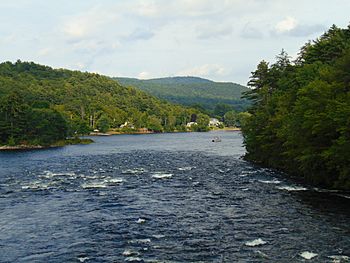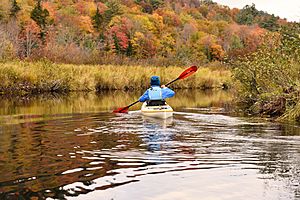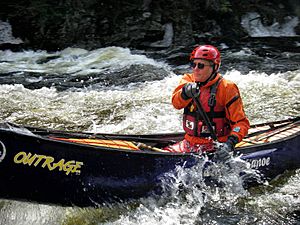Sacandaga River facts for kids
Quick facts for kids Sacandaga River |
|
|---|---|

The Sacandaga River when it flows into the Hudson River
|
|
| Native name | Sa-chen-da'-ga |
| Country | United States |
| State | New York |
| Physical characteristics | |
| Main source | Lake Pleasant 1,726 ft (526 m) 43°28′34″N 74°22′56″W / 43.47611°N 74.38222°W |
| River mouth | Hudson River 545 ft (166 m) 43°18′50″N 73°50′34″W / 43.31389°N 73.84278°W |
| Basin features | |
| Tributaries | |
The Sacandaga River is a 64-mile-long (103 km) river in northern New York State, United States. Its name comes from the Native American language. Sa-chen-da'-ga means "overflowed lands."
This river is a branch, or tributary, of the famous Hudson River. It flows into the Hudson River near Lake Luzerne.
Contents
Journey of the Sacandaga River
The Sacandaga River starts its journey in Lake Pleasant. This area is north of a much larger lake, Great Sacandaga Lake. From Lake Pleasant, the river flows a short distance. This part is called the Sacandaga Outlet. It goes into Lake Pleasant itself.
The river then leaves Lake Pleasant near the village of Speculator. Here, it winds through wet areas and different natural places. In Speculator, you can find the Sacandaga River Community Park. Local people built this park. It has boardwalks and paths that follow the river.
Waterfalls and Man-Made Lakes
Near the towns of Wells and Lake Pleasant, the river flows into a series of ponds. The Sacandaga River then drops steeply. It creates several beautiful waterfalls. These include Christine Falls and Auger Falls.
The East Branch of the Sacandaga River joins the main river in Wells. After flowing through Wells, the river enters Lake Algonquin. This is a man-made lake. It was built in the 1920s to help bring tourists to the area.
Flowing to Great Sacandaga Lake
The Sacandaga River flows out of Lake Algonquin. It passes a hydro-electric plant. This plant uses the river's power to make electricity. The river then goes through rapids. It flows into Great Sacandaga Lake. This happens as it passes through the towns of Hope and Benson.
In this area, another stream called Groff Creek joins the Sacandaga. Finally, the river enters Great Sacandaga Lake near the village of Northville. It flows through this large lake. Then it reaches the Conklingville Dam. After the dam, the river enters the town of Hadley. This is where it finally meets the Hudson River.
Fun on the River
Below Stewart's Dam in Hadley, people can enjoy whitewater rafting. The company Brookfield Energy sometimes releases water. This creates a two-mile stretch of exciting rapids. It's a great spot for kayakers and canoeists.
How the River Flows
Scientists use special tools to measure how much water flows in rivers. These tools are called stream gauges. The United States Geological Survey (USGS) has several of these along the Sacandaga River.
For example, one station is near Hope. On March 27, 1913, it measured a very high flow. On September 30, 1913, it measured a very low flow. Another station near the river's end has been working since 1907. It also recorded very high and very low flows over the years. After the Great Sacandaga Lake was built in 1930, the river's flow changed. The highest flow recorded since then was on May 2, 2011.
Rivers Joining the Sacandaga
Many smaller streams and rivers flow into the Sacandaga River. These are called tributaries. They add water to the main river.
Tributaries from the Right Side
- Johnson Vly Stream
- Shanty Brook
- Dunning Creek
- West Branch Sacandaga River
- Groff Creek
- Petes Creek
- West Stony Creek
- Cloutler Creek
- Batcheller Creek
- Gordons Creek
- Daly Creek
- Breen Brook
Tributaries from the Left Side
- Kunjamuk River
- Fly Creek
- Robbs Creek
- Macomber Creek
- East Branch Sacandaga River
- Mill Creek
- Coulombe Creek
- Doig Creek
- East Stony Creek
- Beecher Creek
- Sand Creek
- Glasshouse Creek
- Paul Creek
- Allentown Creek
- Bell Brook
- Mink Brook
- Man Shanty Brook
The Conklingville Dam and Great Sacandaga Lake
The Conklingville Dam was finished in 1930. It is located near the town of Hadley. This dam made the Sacandaga River much wider. It created the large body of water we now know as Great Sacandaga Lake. This lake was once called the Great Sacandaga Reservoir.
Images for kids






